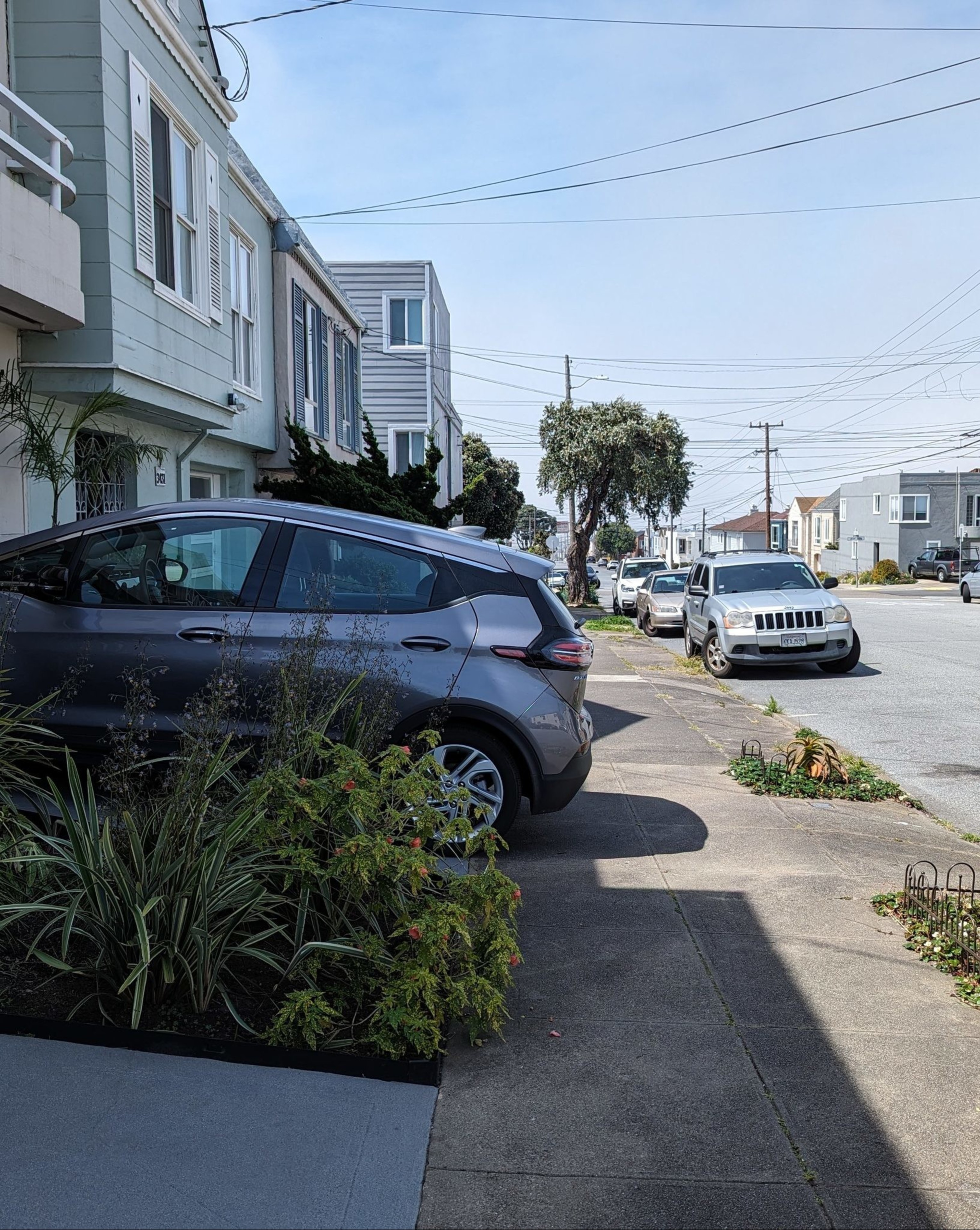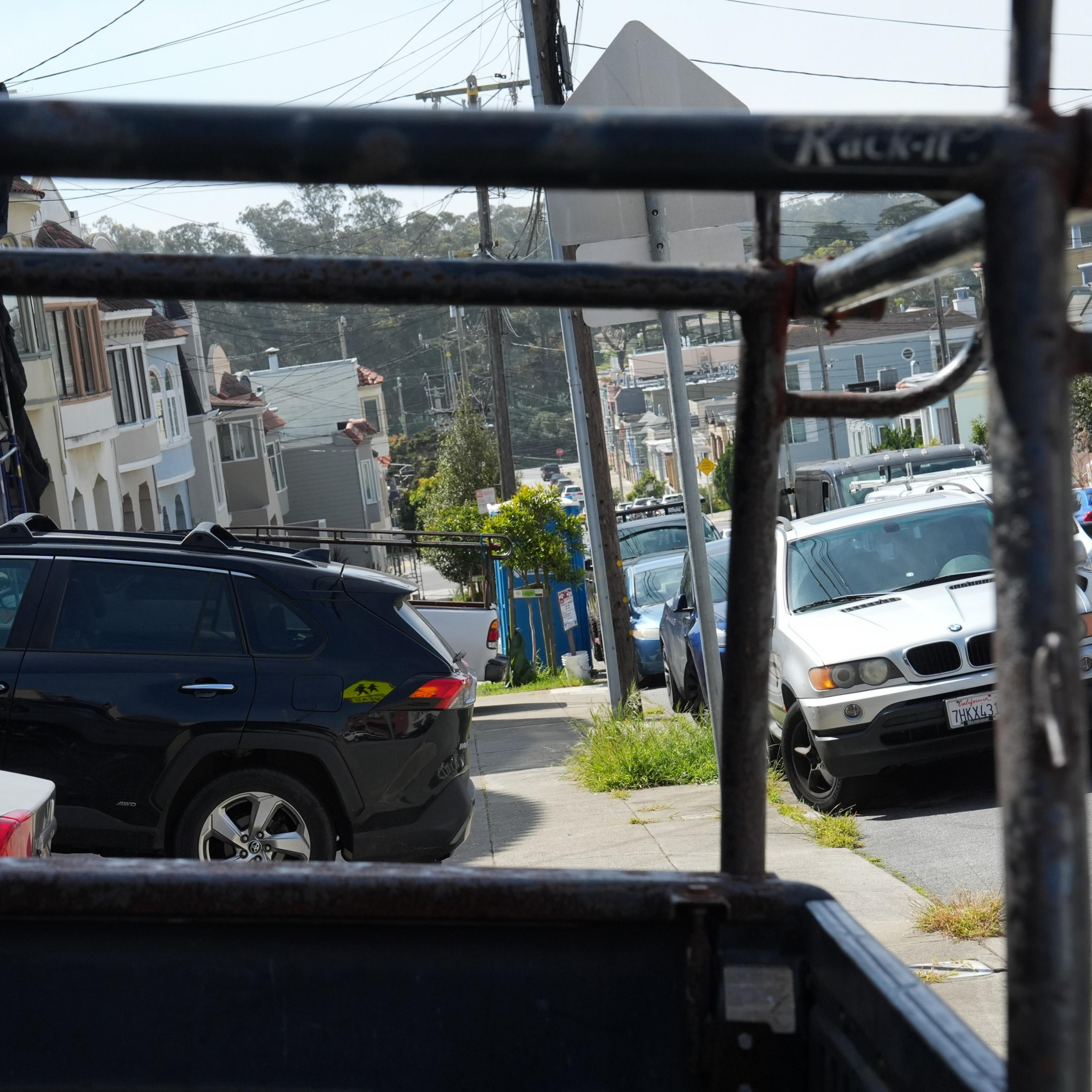Molly Calcagno is a lifelong San Franciscan whose Chevy Bolt was jutting a foot or two past her driveway onto a Sunset neighborhood sidewalk on Wednesday. It was easy for a pedestrian to stroll past her car and stay on the sidewalk. But she was still likely running a risk of getting ticketed under state Vehicle Code Section 22500 (opens in new tab), which prohibits drivers from letting even a portion of their vehicles extend over the walkway.
Why doesn’t she simply park the car in her garage?
That question was posed repeatedly (opens in new tab) about a Richmond neighborhood resident, often in less polite terms, after he went viral on X for crying foul over a $108 parking citation he received for partially blocking the sidewalk while most of his Prius was sitting in his own driveway.
The reader response to The Standard’s coverage of the controversy made it clear that this was not an isolated incident. Residents from across San Francisco wrote in explaining that people in their neighborhoods habitually try to stuff cars into too-short driveways, leaving part of their vehicles extending into the pedestrian walkway.
What’s behind this phenomenon of sidewalk blocking? The Standard hit the streets of San Francisco’s residential neighborhoods to find out, asking driveway parkers blocking at least some of the sidewalk one simple question: Why not put your vehicle in your garage?

The answers ran the gamut, including the downsides of historical architecture, the challenges of owning an electric vehicle and the fear of car break-ins.
Longtime practitioners of sidewalk blocking may be in for a rude awakening, as Mayor London Breed has directed the San Francisco Municipal Transportation Agency to up enforcement of laws that ban obstructing sidewalks, blocking crosswalks and parking too close to intersections. Those practices put pedestrians and bicyclists at risk, especially people using wheelchairs or other devices to get around, by forcing them into the street, according to a Mayor’s Office spokesperson.
Breed and other city leaders have placed renewed emphasis on street safety in the wake of a crash that killed a family of four in March, a tragedy that highlighted the city’s failure to eliminate traffic deaths through its Vision Zero initiative.
What’s a reasonable amount to block the sidewalk?
So why doesn’t Calcagno put her Bolt in the garage? Because her family’s other car was already occupying that single slot. While Calcagno normally street parks whichever car isn’t in the garage, they’re both electric vehicles and were charging simultaneously on Wednesday, she explained. To charge her Bolt while street parking, she would have to stretch the charging cable across the sidewalk, creating a tripping hazard.
“I don’t want to get sued,” Calcagno said.
She doesn’t hate the idea of the city cracking down on vehicles that are completely blocking the sidewalk, but she wants officials to use discretion. So long as there’s space for a person using a wheelchair or walker to get by on the sidewalk, the city should give parkers some grace, according to Calcagno.
“I think there needs to be some reasonableness,” Calcagno said.

That was the consensus among the 10 sidewalk blockers The Standard interviewed, all of whom had left at least some sidewalk space for pedestrians to navigate around.
Issuing citations based on the letter of the sidewalk-blocking law—instead of looking the other way so long as a person in a wheelchair can get by—is just another example of the city screwing over working-class inhabitants, who may struggle to pay pricey fines, according to a Sunset resident named Ted, who declined to give his last name.
“Things like that are just a ploy to get money out of people who are already working too hard,” Ted said.
But people without disabilities vastly underestimate how treacherous it can be to navigate all the obstacles on city sidewalks, according to Leslie Stepp. Her rheumatoid arthritis has forced her to walk with a cane, complicating journeys from her Pacific Heights home, Stepp said.
That’s because she’s often not the only person on the sidewalk. She may come across dog walkers, people pushing strollers and more, leaving her wondering, “How am I going to get around this?” A car jutting into the walkway makes that situation all the more challenging.
She says she has fallen twice trying to get around cars poking into the sidewalk, once as a person pushing a stroller squeezed by simultaneously, forcing her onto the driveway decline, where she twisted her ankle and ended up on the ground.
That’s why she has no sympathy for the idea that there is a reasonable amount of space that should be allowed for a car to encroach on the walkway.
“If [people blocking the sidewalk] want to rationalize their way around it, that’s great, but they should still be ticketed,” Stepp said. “The truth is, the sidewalk is for people, not cars.”
Why are these garages so small?
David Jacoby, the Richmond neighborhood resident who kicked off the original parking controversy, said that he didn’t park in his garage because his Prius simply didn’t fit.
That’s not uncommon, according to longtime San Francisco building permit consultant Jeremy Paul. Virtually every house west of Twin Peaks erected before 1950 was built with a garage door that’s too narrow for a modern car, Paul said. He’s worked on many projects to widen garage doors so they can fit a Tesla or a Range Rover.


Meanwhile, neighborhoods such as the Western Addition, Mission, Russian Hill and Noe Valley are chock-full of homes built before everyday people owned automobiles, according to San Francisco Heritage President Woody LaBounty. Many of these homes, constructed pre-1910, were built to have a half story of open space underneath to get the house off the ground and away from the muddy, sandy streets of the era.
Once automobile ownership became commonplace, companies began turning those empty basement-level half-stories into garages, explaining why so many San Francisco garages have steep, declining driveways and shallow roofs, according to LaBounty. About a third of San Francisco homes were built before garages were widespread, LaBounty estimates.
Many of the driveway parkers The Standard spoke with had alternative uses for their garage space. One teen, who declined to give their name, explained that their family had converted the garage into a relaxation zone so they could have a refuge from their younger siblings. David Turner, meanwhile, said he had a home gym set up in the garage, outfitted with a bench press, squat rack, heavy bag and pullup bar.

Other driveway parkers, however, didn’t even live in the attached home. Robyn Teisi commutes from the East Bay to San Francisco to work as a caregiver. She said she started parking in her client’s driveway after her car was broken into twice on city streets.
Teisi was the only driver who cited security concerns. Many others, whether their garage was filled with another car or being used to store things, didn’t see parking inside as an option. As for why they chose to use their driveways instead of street parking, there was a common thread.
It was summed up by the owner of a blue Tesla who didn’t want to share her name.
“It’s so I don’t have to find a parking spot,” she said.
